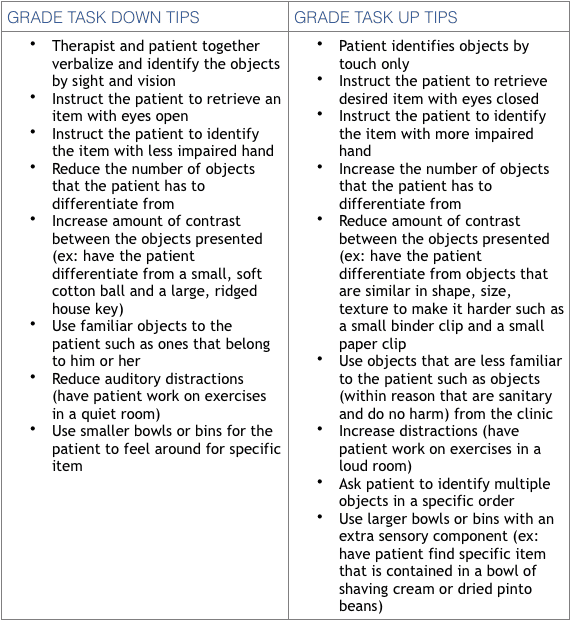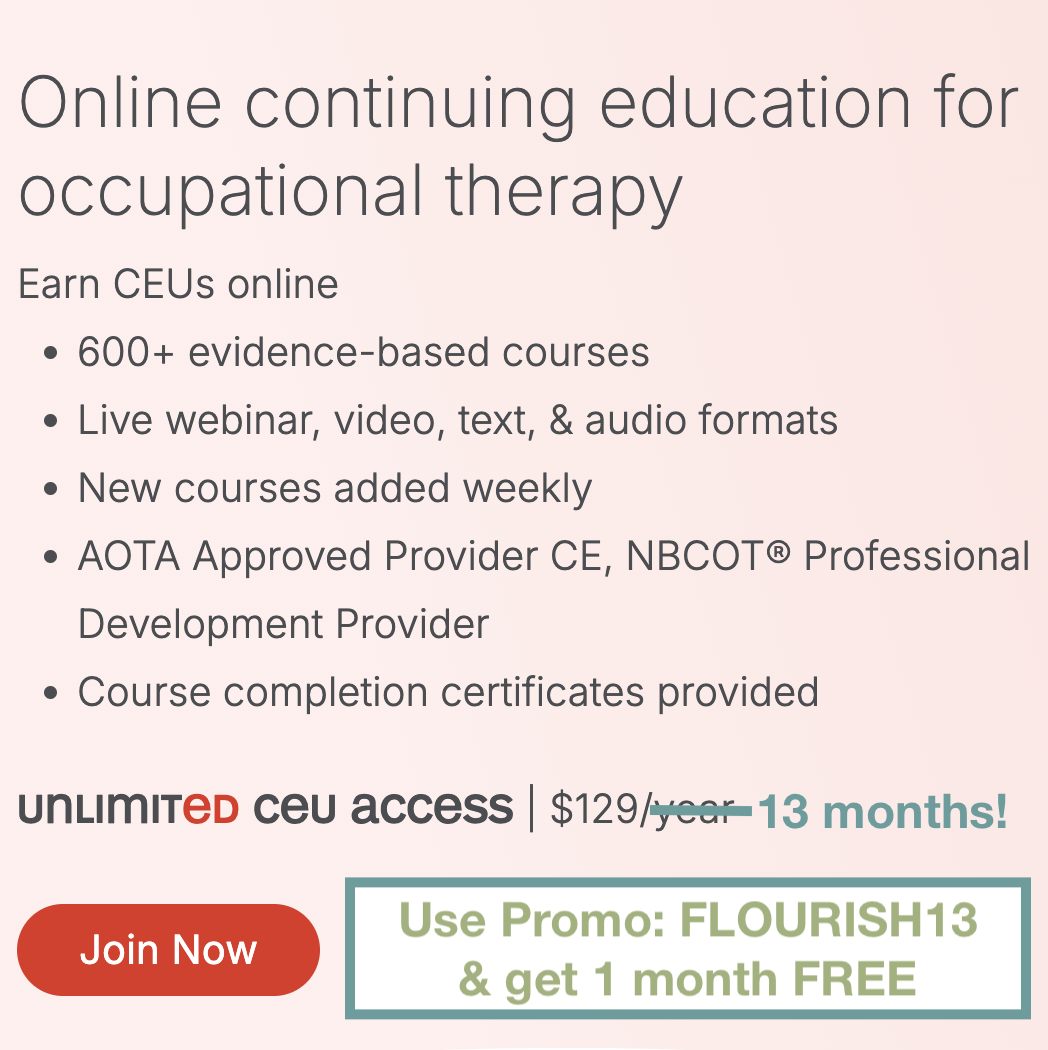We are now digging into how to grade a stereognosis treatment when you are working with adults in OT, PLUS a case study to give you some really concrete examples.
If you haven’t checked out the rest of the series, let’s recap…
In Part 1 of this 2-part article series we got into the “who”, “what”, “when”, “where”, and “why” about stereognosis and what it has to do with occupational therapy and adults. Part 2 went go over the “how” to incorporate testing into your OT stereognosis assessment and screening. Then in Part 3 of the series (this one – yea!), we will dive into “how” to down grade and up grade a stereognosis treatment and activity example!
HOW to grade down or grade up stereognosis intervention and activities?

Stereognosis Activities Sample
Background:
Dr. Jay is a 76-year old patient admitted to acute inpatient rehab secondary due to fall onto left side warranting a left total hip replacement. Weightbearing as tolerated on left lower extremity. No surgical intervention warranted for left upper extremity per ortho and assessment. Patient is hardworking and working on ADL, IADL, functional mobility, fall prevention, endurance, and strength related goals. His goals include going home “stronger and independent as ever….and to get back into my volunteer time at the clinic”. By his third day of OT treatment, Dr. Jay was able to don his pants and socks again with adaptive equipment with minimal pain; however, he reported feeling a little disappointed in the fact that he was having trouble tying his bowtie. This was something not brought up upon initial OT evaluation.
The OT observed and noted that the difficulty stemmed from his inability to easily find the loophole for his bowtie to go around. impacts his occupational role of being associated as “the retired bowtie doc”. In addition to providing patient with encouragement for task adaptation such as recommending sitting in front of a mirror for visual feedback, the therapist prompts patient to discern the meaning attached to his preferred ADL dressing task. He reports that it is important for him to not have to rely on a mirror because he frequently changes between wearing scrubs and professional clothing with his signature bowtie and so “it is just not the same and is not as efficient as when I can put on my bowties quickly without looking”.
Initial Testing Results:
With nonaffected right hand, patient demonstrated 100% accuracy in all stereognostic comparison tests presented included during in hand manipulation of one standard stimulus at a time and when asked to retrieve a specific item out of a group of 10 items; patient completed all tests in a timely manner without signs of difficulty. With affected Left hand, patient scored 60% accuracy during in hand manipulation of one standard stimulus at a time but declined to 50% accuracy when asked to retrieve a specific item out of a group of 10 items; patient required an average of 15 seconds longer per trial in comparison to his nonaffected hand.
Plan:
Facilitate stereognosis training as part of a multimodal approach to improve sensory and ADL outcomes over next 3 sessions. Give “homework” program for patient to perform nightly with spouse outside of therapy time. Reevaluate improvements in 5 days (the last two days are Saturday and Sunday which are non-therapy days).

Homework Stereognosis Example:
Every night reach into your personal box and silently practice locating and identifying 10 out 10 items in the order of your notecard as fast as you can using your left hand. Be sure to not look into the box. Use your touch sense only. Once you feel that you have the correct item, pull it out of the box and open your eyes. Make a record of how many you find and how long it takes you to find them by using your stopwatch.
Graded Down Example:
Therapist asked patient and his spouse for permission to utilize some of their familiar items for stereognosis purposes which included his spouse’s hairtie and bobby pin, an old pen, a Qtip, a rubber band, a nickel, and a few others. Therapist set items that were similar in size or weight to the side to use at a later time.
Graded Up Example:
Dr. Jay improved his left stereognosis in hand manipulation of one standard stimulus at a time to 80% accuracy, his ability to discriminate stimulus within a group of objects to 70% accuracy after 5 days, and reduced his needed duration of time to an average of 8 seconds longer per trial in comparison to his nonaffected hand; therapist determined need to increase the challenge of future activities.
Therapist instructs Dr. Jay to perform stereognostic in standing at tabletop to work on his endurance and tolerance to weightbearing onto his surgical side. Therapist chooses similar sized items that are unfamiliar to Dr. Jay to further challenge him.
Dr. Jay is faced with several distractions including loud talking and recurrent phone ringing. Therapist asks patient to find 2 stimulus at a time (aka is asked to find a bobby pin and a binder clip using his left hand only before taking hand out of container) within a large container with 13 other small objects hidden under dried rice.
Eureka, the best kind of challenge!!
End result
Dr. Jay met all OT and PT rehab goals, discharged from his acute inpatient rehab stay, and visited his therapists at the unit two weeks later upon stopping by after his outpatient PT appointment. PS. he was wearing a bowtie☺ .
**Something else notable to mention-> Based on your clinical judgement you may also choose to test and assess a patient’s graphesthesia ability. Sometimes if a patient cannot hold onto or grasp an object, a graphesthesia assessment may be substituted.
GRAPHESTHESIA is the ability to recognize or identify writing on the skin using touch sensation only. Just as in the case of testing stereognosis, it is good practice to assess, compare, and notate the accuracy of both hands or sides of the body separately.
Check out Part 1 and Part 2 of the stereognosis series for occupational therapy practitioners as this will dive into the “who”, “what”, “when”, “where”, and “why” of stereognosis and what it has to do with occupational therapy and adults as well as provide the nitty gritty “how to” assess and screen for possible stereognosis deficits.
 About our guest blogger
About our guest blogger
Shannen Marie Coley, MS, OTR/L is an occupational therapist that is passionate about adult inpatient rehabilitation, patient wellness, professional development, advocacy, and occupational balance. She is an LSVT BIG certified clinician since 2018. Since graduating OT school in December 2016, Shannen has worked in the hospital and inpatient rehab settings serving adult patients of variable backgrounds, stories, and upbringings with a variety of neurological, cardiopulmonary, orthopedic diagnoses. Shannen enjoys writing and sharing tidbits of OT related stories on her blog ShannenMarieOT.com and is active on Instagram (IG) @shannenmarie_ot. Shannen is married to her college sweetheart and they have one child – a six toed cat named Gravy.




